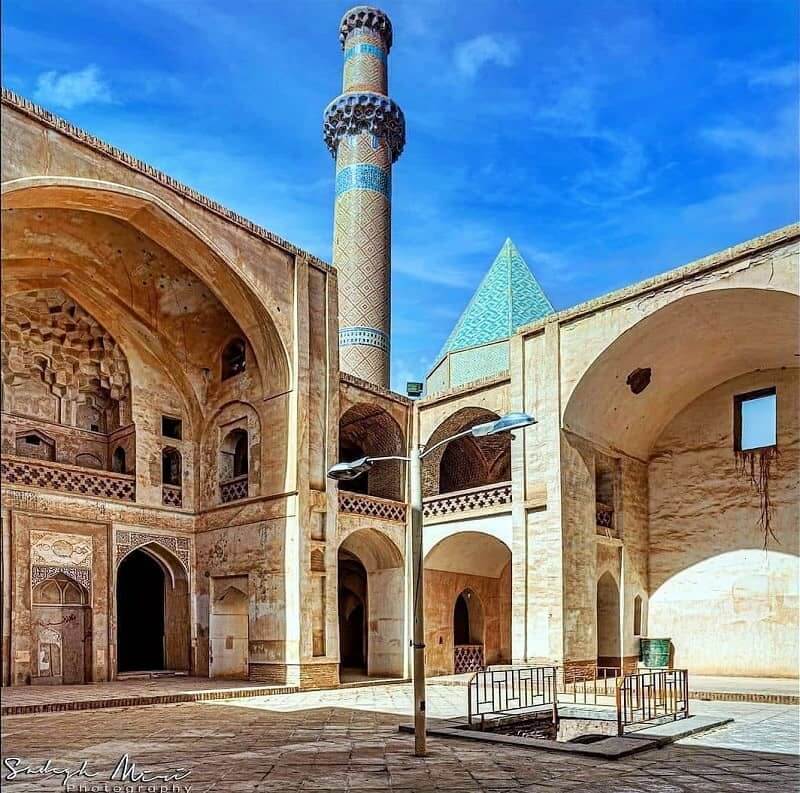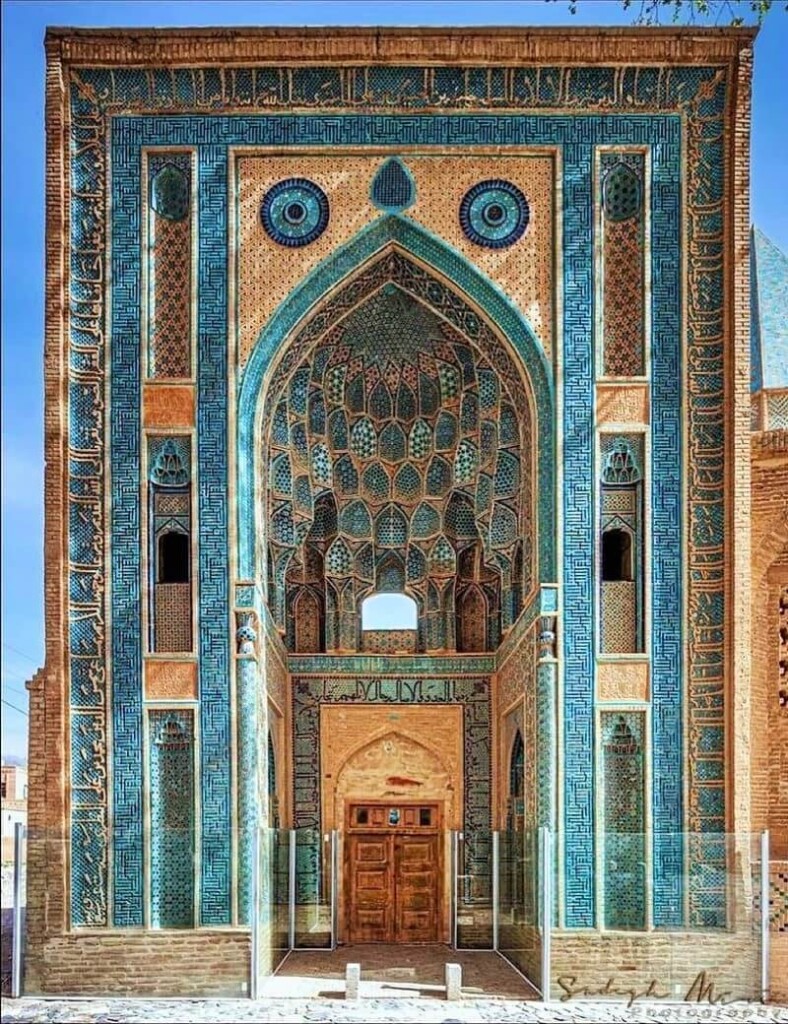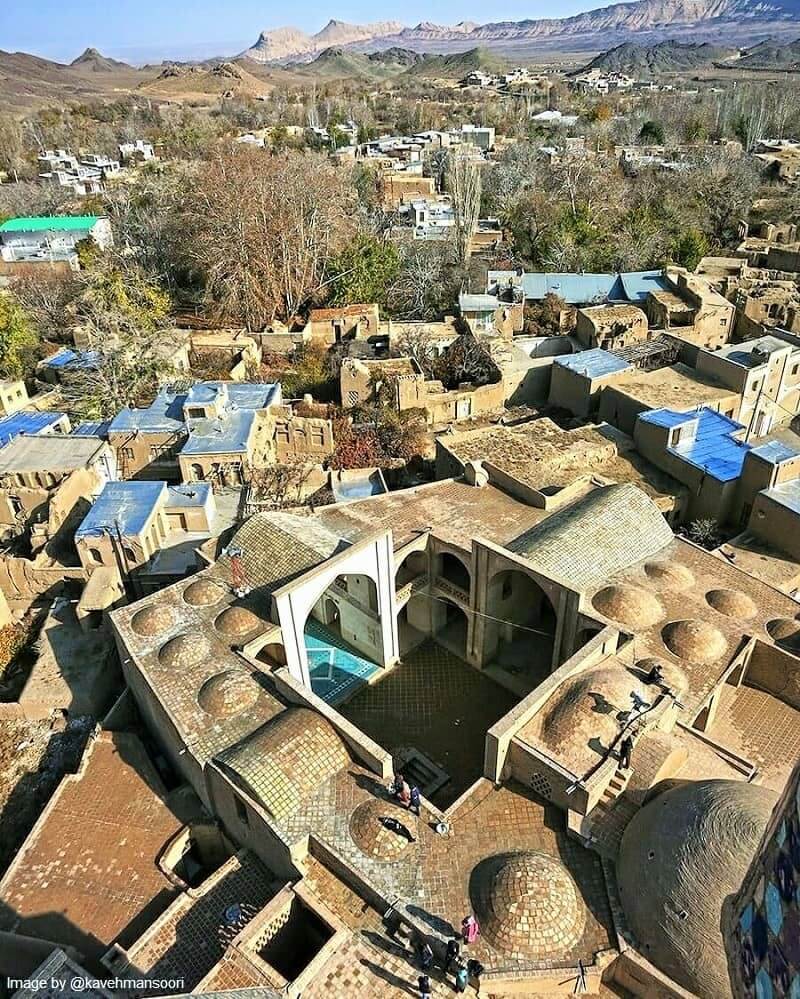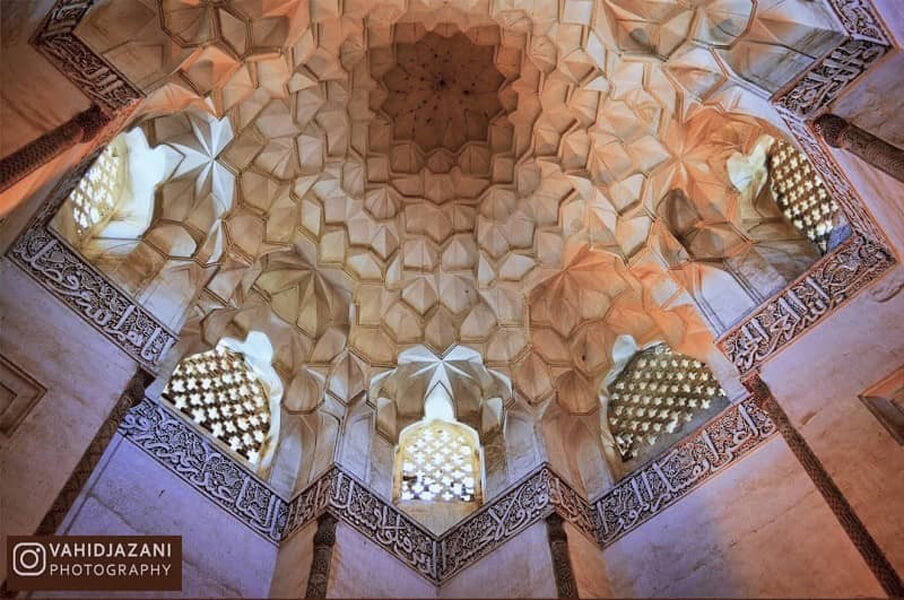
The historical city of Natanz is a city in the northeast of Isfahan, situated at the hillside of Karkas (Vulture) mountain range. Natanz is known as the “Garden City” because of its many gardens and the diversity in the cultivation of plants. This city has 1,800 historical monuments and natural attractions, and the Jameh Mosque of Natanz is among the most significant.
This comprehensive mosque, which is also known as the Friday (Jom’eh) mosque, is a collection of several religious monuments. The complex includes Jameh Mosque, Khanqah, Sheikh Abdul Samad’s tomb, and a 37-meter-high minaret. All these buildings are built in close proximity, but their construction dates are spread across history.

The dome of Jameh Mosque of Natanz was built in the 11th century AD, but most other sections were built in the first half of the 14th century. The construction dates back to the Ilkhanid dynasty, Oljaitu Khodabande and his son Abu Sa’id Bahadur Khan.
Natanz Jameh Mosque Entrances

This mosque has three entrances, two of which are located in the northern area with another in the south. The doors of the northern area are on the same level as the courtyard, while the door to the southern part is 12 steps above the mosque corridor.
This mosque is connected to a narrow alleyway from the north, east and south. This alleyway leads to a rather large entrance facing the minaret and the Khanghah entrance, which is practically a small square.
The southern part of Natanz Jameh Mosque has timber double doors. The door is decorated with skillful Marquetry (wood engraving). Also, the date 825 A.H. (After Hijrah) is engraved on the bottom of the left leaf.
In addition, the northern doors of this mosque open to an adjacent alley. These doors are decorated with marquetry inscriptions that display Salawat (prayer) on the 14 Infallible Imams (a form of Shi’a blessing). These doors were built in 1565 AD and installed on the mosque entrance in 1604 AD.
Domed Octagonal Shabestan (Prayer Hall)
Entering through the mosque door, you will face a relatively vast vestibule. This vestibule is 12 steps lower than the alley, about one and a half meters lower than the alley. On the right side of the vestibule, there is a small corridor that leads you to the domed octagonal Shabestan.
There is an inscription at the base of the Shabestan dome, made with raised bricks. This inscription belongs to the Buyid dynasty. During the Safavid rule, they covered this inscription with plaster and decorated it with plasterwork designs.
The Shabestan of this mosque is older than other sections and dates back to the pre-Ilkhanid era, the Seljuk period. There is an inscription in the Shabestan that claims the dome was built in the 11th century AD. This Shabestan is the oldest part of the mosque and has a Mihrab (altar) with unique tilework.
Features of Jameh Mosque of Natanz Courtyard
After passing through the mosque door and its Shabestan, you will reach the courtyard. The mosque courtyard has 4 iwans (rectangular halls) facing four directions. Its courtyard and iwans have two floors and are 9 meters tall. The two floors of the northern iwan are decorated with muqarnas work, where two inscriptions are found.
One of the inscriptions displays verses from the Quran, engraved on a background of flowers and bushes. The second inscription is placed at the bottom of the iwan crescent. This inscription has a brown background, and verses from the Quran are engraved in white Thuluth script. There are also two hadiths from the Prophet of Islam engraved at the bottom of this inscription.
Materials Used in Constructing Natanz Jameh Mosque
The materials used in Jameh Mosque of Natanz are brick and mortar covered with lime. The mosque has several inscriptions which display the dates of renovations, and names of the architects and the builders. The southern door of the mosque has an inscription with descriptions of the building.
Do Not Miss Visiting This Attraction
Natanz city is a small city in Isfahan that can be accessed by several roads. You can travel to this city by the old Kashan road or the Tehran-Natanz Freeway (Tehran South transit road). The city of Natanz is a great destination for tourism thanks to its many historical monuments.
You can travel to Natanz on an Iran tour package or by yourself. Don’t forget to visit the Jameh Mosque of Natanz if you are visiting this beautiful city. This mosque is one of the historical monuments of ancient Iran and is an exemplary display of the architectural styles of the Ilkhanid and Safavid periods.
Also, don’t forget to go inside the tomb next to this mosque. The plasterworks inside are one of the most unique and beautiful decorations in this complex.

Destination Iran recommends that you read other tourist attractions of Natanz in order to have an informed trip to this city and get to know its sights better.
Where is Natanz Jameh Mosque?
The Jameh Mosque of this city is located in Isfahan province, Natanz city and near the old Bazaar in Natanz. You can see the exact location of this complex below:
Frequently Asked Questions About Natanz Jameh Mosque
If you did not find the answer to your questions below, ask us in the comments section of this post. We will answer them as soon as possible.
What buildings are in the Jameh Mosque of Natanz?
This complex includes a Jameh Mosque, a Khanghah (place for Sufi gatherings), a 37-meters-tall minaret and the tomb of Sheikh Abdul Samad, a famous Sufi from the Ilkhanate era.
Which Period Does Natanz Jameh Mosque belong to?
Most buildings in Natanz Jameh Mosque complex are from the Seljuk period. These buildings are in close proximity, but were built in different eras.
What makes Natanz Jameh Mosque dome special?
According to studies, this dome was built in 998 AD. It is considered the oldest dome in the region. The mosque’s thousand-year-old dome serves as a stunning and colorful sundial. The sundial marks religious hours by allowing light to pass through a specific aperture.
For noon prayers, an azure light shines through the opening in front of the Minbar(pulpit). At Asr (afternoon), the two adjacent apertures change color. So, until sunset, the apertures reflect different shades of light. This clock still works with precision and is one of the amazing features of Natanz Dome.
Where is the entrance to Natanz Jameh Mosque?
This mosque has three entrances and is connected to a narrow alley from the north, east, and south. the alley leads to a small square.
The southern part of Natanz Jameh Mosque has a wooden door with two leaves, which is decorated with skillful marquetry.













